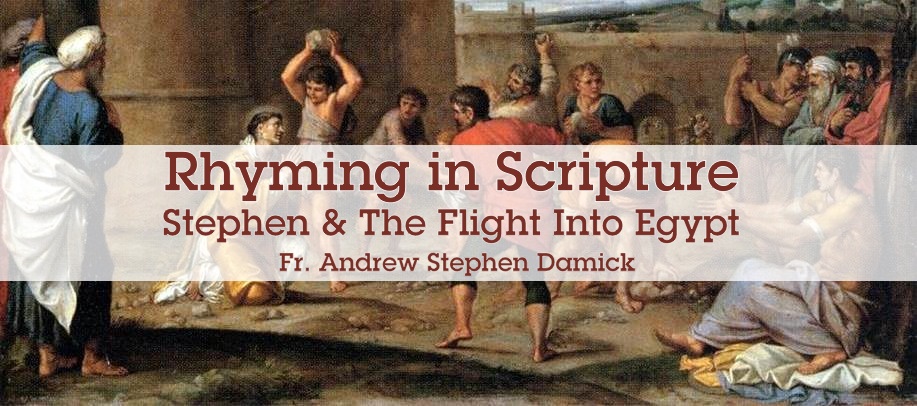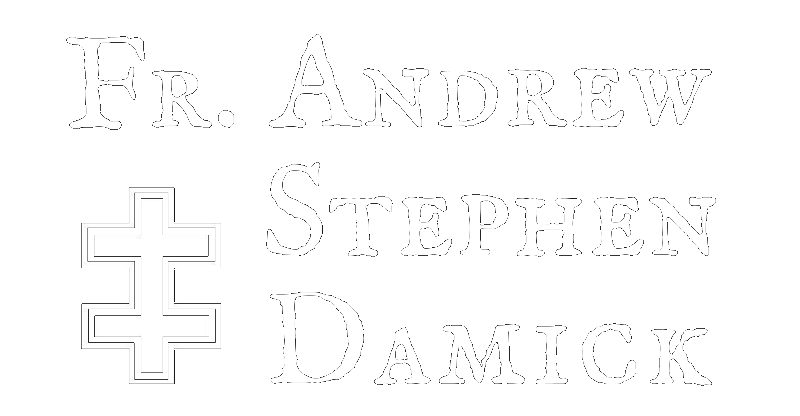
Sunday after the Nativity / Feast of St. Stephen, December 27, 2015
Acts 6:8-7:5, 47-60; Matthew 2:13-23
Rev. Fr. Andrew Stephen Damick
In the Name of the Father and of the Son and of the Holy Spirit, one God. Amen.
Christ is born! Glorify Him!
On the second day after Christmas, we celebrate the holy Proto-martyr and Archdeacon Stephen, and we hear the story of his martyrdom in the reading appointed from the Acts of the Apostles.
And today is also the Sunday after the Nativity of Christ, and in the Gospel reading for this Sunday, we hear how Herod the king slaughtered all the boys two years old and under in the region around Bethlehem in his effort to kill Jesus, and how Joseph took Jesus and His mother into Egypt to escape this massacre.
These two stories that coincide today contain three parallel elements that I would like to discuss.
First, let’s begin with the story of the flight into Egypt. As we have heard in the many readings that were appointed for the Nativity services, the three wise men from the East arrived in Judea looking for the Messiah, the One born King of the Jews. It is likely that it took about two years from the time Jesus was born until they made it to Judea. Upon coming to the region, they went first to King Herod and told him why they were there.
We have to imagine how Herod must have felt—three wise men from Persia come and tell him that a miraculous star has shone in the heavens, telling them of the fulfillment of a prophecy, that one had been born King of the Jews. But isn’t Herod the King of the Jews? Yes, the Romans had set him up as a client king under their rule, but Herod himself was actually not a Jew but a foreigner. So when he is told that an ancient Jewish prophecy was fulfilled about the Messiah, the coming King of the Jews, he felt threatened. This was not his own son that had been born. Who was this Who was going to be king but not of his own line? That is the first parallel element—the threat to the established order.
In the story of Stephen, the Scriptures tell us that he was “full of grace and power,” that he “did great wonders and signs among the people.” And it also tells us that some in the various synagogues in the area of Jerusalem began to get into theological arguments with him, “but they could not withstand the wisdom and the Spirit by which he spoke.”
This infuriated these Jews, who were probably not used to being defeated in theological debate. And especially with the miracles that Stephen was performing, and the “grace and power” with which he spoke, full of “wisdom and the Spirit,” it became clear that Stephen was upsetting everything. He was an uncontrollable element, something outside of their authority. And so, Stephen, just like his Master, was a threat to the established order.
As we move further along in the story of Herod’s reaction to Jesus’ birth, we find him trying to get the wise men to do his dirty work for him. He told them to find the Child and report back where he was, supposedly so that Herod could come and worship Him, but in reality so that Herod could eliminate this threat. The wise men do find the infant Messiah, but they do not report back to Herod, since an angel came to them in a dream and told them not to.
Then Herod, as the Scripture says, “in a furious rage” because the wise men defied him, “sent and killed all the male children in Bethlehem and in all that region, who were two years old or under.” According to tradition, the number of those little boys—from toddlers down to infants—who were killed for the sake of Christ was 14,000. “Then was fulfilled what was spoken by the prophet Jeremiah: ‘A voice was heard in Ramah, wailing and loud lamentation, Rachel weeping for her children; she refused to be consoled, because they were no more.’” And this is the second parallel element between these stories—death for the sake of the Messiah.
In the story of Stephen, when these leaders of the synagogues saw that he was ruining their established order, they stirred up people to give false witness against Stephen, to claim that he had blasphemed against the Temple and against the Law of Moses, acts which were punishable by execution. They put him on trial, and Stephen uttered a prophetic sermon to them in the midst of the trial, accusing them of the deaths of the prophets, of betraying the Law of Moses, and of murdering the Righteous One of Israel, that is, Jesus the Messiah.
And in their fury, like Herod, they demanded his life and began to stone him. And as those huge rocks and boulders smashed into his body, breaking it and crushing his bones, Stephen looked up into heaven and spoke of what he saw: “Behold, I see the heavens opened, and the Son of Man standing at the right hand of God.” The Lord Jesus, Who after His ascension had sat down at the right hand of the Father, now stood so that He might receive this first martyr, the Proto-martyr who was the first to volunteer his life for his faith in the Son of Man.
And as he died, he asked that God would receive his spirit, and also that He would forgive them who killed him. And so in the story of Stephen we also see the second parallel element—death for the sake of the Messiah.
Finally, in the story of Jesus, we also see an angel coming to Joseph and saying, “Rise, take the Child and His mother, and flee to Egypt, and remain there until I tell you; for Herod is about to search for the Child, to destroy Him.” This actually happens before Herod begins his search, but it is because of what Herod was about to do that Joseph took Jesus and the Virgin to Egypt. They stayed there for some time until Herod had died. Tradition says that, when Jesus arrived in a certain city in Egypt, all the pagan idols in the city fell down on their faces. And this therefore is the third parallel element—the escape, resulting in the defeat of false belief.
In the story of Stephen, we do not hear of the parallel escape in this passage from Acts 6 and 7 we read today. But if you read the first few verses of the next chapter, you will see it there. It is not Stephen who escapes, of course, for he is dead. Rather, it is the believers in Jerusalem. Seeing that Stephen had been stoned, and also because a persecution now arose in Jerusalem against the Church, Christians begin to run. They run for their lives. If they killed Stephen, everyone was at risk. And so the Christians scattered all over the region of Judea and Samaria, bringing their faith with them. And Christianity begins to spread outside Jerusalem.
And while the Jews had been stoning Stephen, standing by and holding the garments of those who stoned him was a man named Saul. In chapter 8, we read how Saul led the persecution of the Christians. But someday, he would be struck down on the road to Damascus, and everything would change. At this point, he was not yet converted to Christ, but he someday would be, and would be called Paul, the Apostle to the Gentiles.
And so the escape of the believers from Jerusalem began the spread of the Gospel into the surrounding area. And the stoning of Stephen, which must have haunted Paul after his conversion, also led to the conversion of the Gentiles. This is again the third element—the escape, resulting in the defeat of false belief.
Is it not beautiful how, with all happening within God’s will and providence, we often see the stories of Scripture have this feeling of “rhyming” between them? There are multiple times we see this beauty in Scripture, where two or more stories will have these common elements between them. In this case, we see at least three: the threat to the established order, the death for the sake of the Messiah, and the escape that leads to the defeat of false belief.
So we also ask ourselves: Does my life “rhyme” with Scripture? How am I bringing myself into this great Story of salvation? As we continue to celebrate Christmas, may we contemplate this for ourselves. And may we find ourselves in the story of Jesus, just as Stephen did.
To the Incarnate Messiah and Lord Jesus, with His Father and Holy Spirit, be all glory, honor, and worship, now and ever, and unto ages of ages. Amen.



